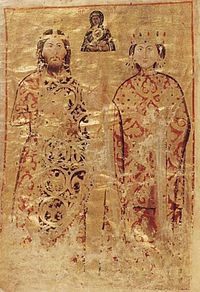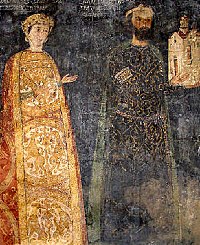Sebastokrator
Sebastokrator ( Middle Greek σεβαστοκράτωρ , "venerable regent") was an imperial Byzantine court title , which was introduced in 1081 by Emperor Alexios I Komnenos . The feminine form was Sebastokratorissa .

history
Origin and early use
The first Sebastokrator was Isaak Komnenos , the older brother of Emperor Alexios I. As Anna Komnene reports, Alexios created the title in order to raise Isaac above his brother-in-law and former rival to the throne Nikephoros Melissenus, to whom he had promised the second highest title Emperor until then . Alexios combined the new title from the traditional imperial attributes Sebastos ( Latin Augustus ) and autocrator ( imperator ). The Sebastokrator was thus, as it were, a second basileus or vice-emperor; the emperor was subordinate to him and was ranked third in the court ceremony in the order of homage. With the introduction of the despot in 1163 by Manuel I , the sebastocrator fell back to third and the emperor to fourth.
The honorary title was not associated with any civil or military authority, but had a purely representative character. On official occasions, the sebastocrator wore blue official costume and a diadem that was far less ostentatious than the imperial crown ; Around 1260 those sebastokrators who belonged to the imperial family were highlighted by embroidered golden eagles on their shoes. The Sebastokrator also had the privilege of signing documents with a special blue ink .
Further development
The title of sebastocrator was reserved for the highest aristocracy in the 12th and early 13th centuries. As a rule, it was only given to younger sons or sons-in-law, brothers, brothers-in-law or uncles of the ruling emperor. After the collapse of the Byzantine Empire as a result of the Fourth Crusade in 1204, the title was also awarded in the successor states , the empires of Nikaia and Thessaloniki . The Latin emperors also adopted the title in their court hierarchy, as did the tsars of the Second Bulgarian Empire .
After the restoration of the Byzantine Empire in 1261 under the paleologists , the Sebastokrator lost its importance as a dynastic title. The emperors now increasingly awarded it to de facto autonomous feudal lords in the provinces to emphasize their formal recognition of Byzantine suzerainty . In the second half of the 14th century the title went out of use; last known Byzantine carrier was Demetrius I Cantacuzenus that it in 1357 by Emperor John V received.
In medieval Serbia the title of Sebastokrator was introduced in 1345/46 under Emperor Stefan Dušan , who used it to honor some of his most important military leaders and magnates . Dušan's successors from the Nemanjić dynasty , Stefan Uroš V and Simeon Uroš Palaiologos , awarded the title until 1371.
Well-known title holders


Central Byzantine Empire
- Isaak Komnenus , brother of Alexios I.
- Andronikos Komnenos , son of Alexios I.
- Isaak Komnenus , son of Alexios I.
- Andronikos Komnenos , son of John II.
- Isaak Komnenus , son of John II.
- Manuel I. Comnenus
- Johannes Dukas Komnenos , nephew of Manuel I.
- Manuel Komnenos , son of Andronikos I.
- Alexios Komnenos , illegitimate son of Manuel I.
- John Dukas , uncle of Isaac II.
- Constantine Angelos Dukas , brother of Isaac II.
- John Petraliphas
- Alexios III Angelos
- Stefan Nemanjić , son-in-law of Alexios III.
- Alexios Palaiologos , son-in-law of Alexios III.
- Isaak Komnenos Batatzes , son-in-law of Alexios III.
- Nikephorus Petraliphas
Second Bulgarian Empire
- Stres , brother (?) Of Boril Assen
- Alexander Assen , brother of Ivan II Assen
- Peter , brother-in-law of Michael II. Assen
- Kalojan , cousin of Konstantin Tich Assen
- Radoslaw , brother of Smilez
Latin Empire
Empire of Nikaia
- Nikephoros account Stephanos
- Sabbas Asidenus
- Georg Laskaris , brother of Theodor I.
- Alexios Laskaris , brother of Theodor I.
- Isaak Laskaris , brother of Theodor I.
- Isaak Dukas Batatzes , brother of John III.
- Johannes Dukas Batatzes , nephew of Johannes III.
Empire of Thessaloniki
- Georg Komnenos (?)
Late Byzantine Empire
- Johannes Dukas Palaiologos , brother of Michael VIII.
- Constantine Tornikes
- Johannes Tornikes
- Konstantin Palaiologos , half-brother of Michael VIII.
- John I. Dukas
- Constantine Dukas
- Theodoros Angelos
- John II Dukas
- Stefan Gabrielopulos
- Andrea I. Muzaka
- Isaac Dukas
- Momchil
- John Angelos , cousin (or nephew) of John VI.
- Manuel Asanes , brother-in-law of John VI.
- John Asanes , brother-in-law of John VI.
- Nikephoros Kantakuzenos , cousin of John VI.
- Andronikos Asanes , nephew of John VI.
- Demetrios I. Kantakuzenos , grandson of John VI.
- Gjin I. Muzaka
- Gjin Zenevisi
Greater Serbian Empire
- Jovan Oliver
- Dejan , brother-in-law of Stefan Dušan
- Branko Mladenović
- Vlatko Paskačić
- Blaž Matarango
swell
- Georgios Akropolites 173 (ed. August Heisenberg , BSGRT Vol. 1–2, 1903, reprint 1978)
- Anna Komnene , Alexias 3, 4 ( ed.Diether Roderich Reinsch , 2001)
- Pseudo-Kodinos , De officiis , 147–148 (ed. Jean Verpeaux, 1966)
literature
- Ivan Biliarsky: Word and Power in Mediaeval Bulgaria (= East Central and Eastern Europe in the Middle Ages, 450–1450. Vol. 14). EJ Brill, Leiden 2011, ISBN 978-90-04-19145-7 , pp. 294-302.
- Божидар Ферјанчић: Севастократори у Византији. In: Зборник радова Византолошког института 11, 1968, ISSN 0584-9888 , pp. 141-192 ( PDF file; 4.0 MB ).
- Божидар Ферјанчић: Севастократори и кесари у Српском царству. In: Зборник Филозофског факултета 10-1, 1970, ISSN 0352-5546 , pp. 255-269 ( digitized version ).
- Alexander P. Kazhdan (Ed.): The Oxford Dictionary of Byzantium . Oxford University Press, New York NY 1991, ISBN 0-19-504652-8 .
- Ruth Macrides, Joseph A. Munitiz, Dimiter Angelov: Pseudo-Kodinos and the Constantinopolitan Court: Offices and Ceremonies (= Birmingham Byzantine and Ottoman Studies . Vol. 15). Ashgate, Farnham 2013, ISBN 978-0-7546-6752-0 .
